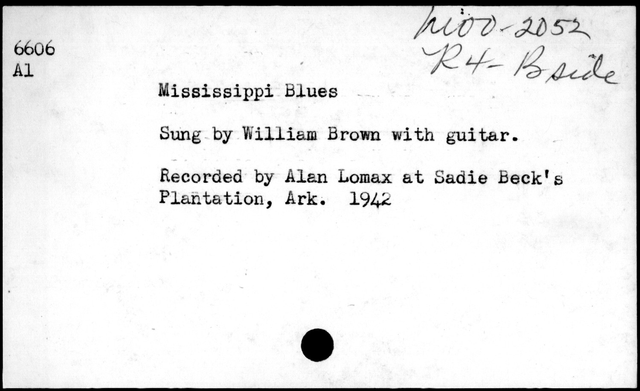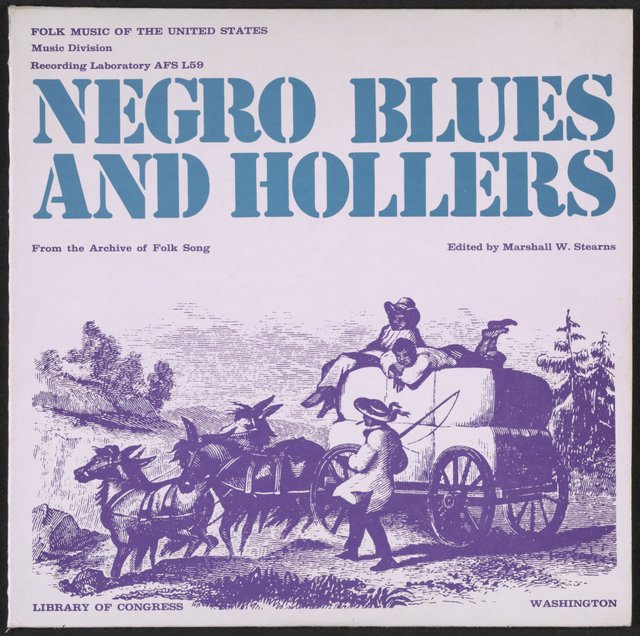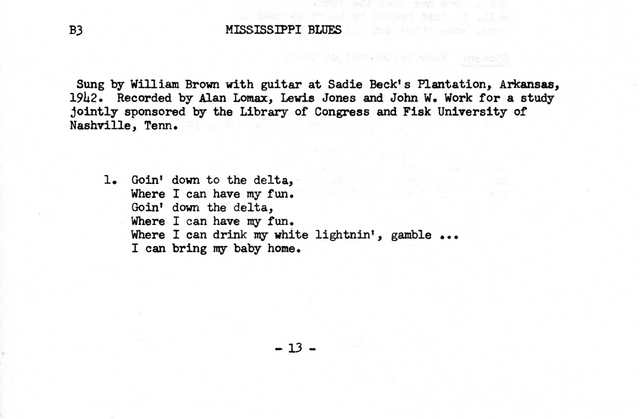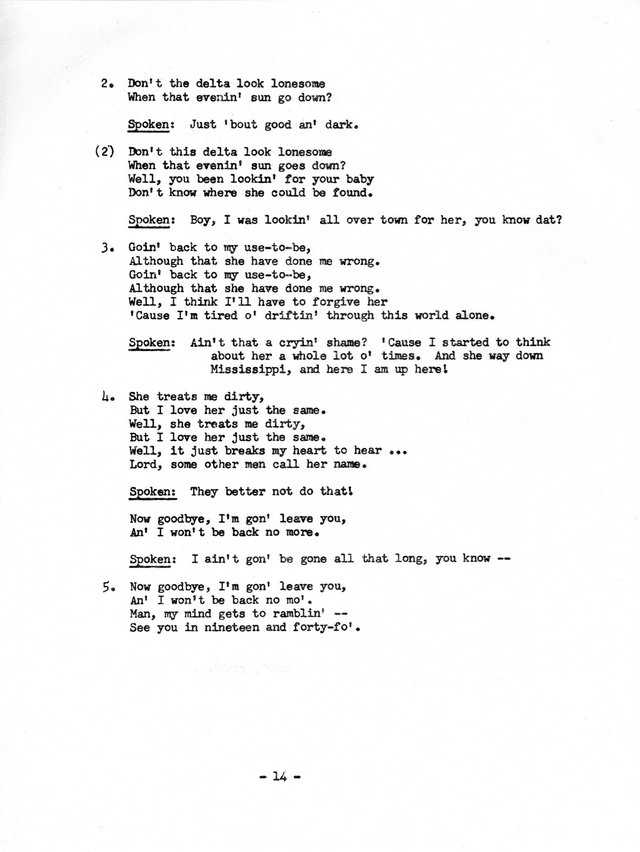VintageBlues4K E03: "Mississippi Blues" by William Brown (1942)
VintageBlues4K
Guitar blues of the 1930s brought to life in UHD 4K video, for the second century of recorded blues fans.
Episode 03: “Mississippi Blues” by William Brown (1942)
Intro
Welcome to the third episode of VintageBlues4K. They call me “Ramblin’ Bob”.
This episode’s selection is from the greatest phantom of the Vintage Blues era, “William Brown”. Many early bluesmen are considered mysterious, with poorly documented lives, but this guy is the champion. There are no photographs. We have no birthdate. No date of death. (Or maybe he’s still alive?) No family history. No remembrances from fellow bluesmen. And no additional biographical information, apart from the three solo and three accompanied recordings he made for the greatest archivist of the blues, Alan Lomax, that have been freely available for the past 74 years in the world’s greatest repository of knowledge, The Library of Congress.

The Song
Clocking in at over 6 minutes long, “Mississippi Blues” is by far the longest song I’ll be playing in this series. It’s more than twice as long as the typical commercial blues recordings of its day, which were limited to the 3 minute sides of the 78 rpm singles sold at the time. Lomax captured this gem with portable field recording equipment in a shack in a cotton field, as part of a joint study of Mississippi Delta folk music sponsored by The Library of Congress and Fisk University of Nashville, Tennessee. It was never intended to be released as a commercial recording, or to fit on a 3 minute record, therefore it is a rare, authentic glimpse of how blues music was probably played at the house frolics and juke joints of the time. With its ongoing repeating verses, solos, and instrumental breaks, it’s easy to imagine this type of song stretching to perhaps 15 or 20 minutes with additional couplets thrown in, well into the wee hours of the night.
With the other two solo recordings William Brown made for Lomax that day, the origins are clear. His “East St. Louis Blues” is a version of an early blues standard, popularized by The Father of the Blues, W. C. Handy, and “Ragged and Dirty” is a remake of a 1929 Sleepy John Estes record, which was a remake of Blind Lemon Jefferson’s 1926 record “Broke and Hungry”. While there are plenty of songs with similar titles and lyrics about the Mississippi River or Mississippi Delta from the era, I don’t know exactly where Mr. Brown got “Mississippi Blues” from. If you know, or have a plausible theory, please post in the comments.
The Recording
On Thursday July 16, 1942, while Jews were being rounded up in Nazi occupied Paris, Alan Lomax was at Sadie Beck’s Plantation in Arkansas to record William Brown and “Willie B.” whom he’d found the previous evening across the Mississippi River in Memphis, Tennessee.
Since approximately 1962, The Library of Congress has made William Brown’s recordings available on a vinyl LP compilation album titled “Negro Blues and Hollers”:

and these days you can even download a digital version right from their web site.
Lyrics
Thanks to the librarians at The Library of Congress:


Picking
I play this song with a Robert Johnson-style thumb pick and a bit of palm muting on the bass strings. I think he might have originally played it with a bare thumb but we can’t be exactly sure. It’s thought that he recorded with a metal bodied National resonator guitar in standard tuning, capoed on the third fret to play in the Key of C.
With three part, polyrhythmic fingerpicking, partial barres, the occasional bass notes thumbed from over the top the of fretboard, and offbeat “swing” notes, by all means this is an advanced blues song to play like him.
While many guitar blues songs of the era had two distinct voices, the main repeated musical motif of Mississippi Blues is a particularly advanced three part polyrhythm. The thumb plays the steady alternating bass, the index finger picks a melody of triplet notes in the middle, and the middle and ring fingers play the offbeat chord embellishments on the high treble strings.
Apparently, William Brown also played guitar left-handed.
Mysterious Bill
We don’t know for sure if William Brown was his real name, or if he’s the same “Willie Brown” that recorded with Charley Patton a decade earlier, or if he’s the “Willie Brown” credited with the definitive 1941 recording of the blues standard “Make Me A Pallet On Your Floor”.
Rather than attempt to recreate what we do know of this detective story, I’ll defer to the excellent William Brown biographical writeup on 52 Weeks of Blues.
The Land Where The Blues Began
The events surrounding William Brown’s recordings were immortalized in the first chapter of Alan Lomax’s memoirs, which is also where the mystery really begins. Lomax felt the need to include this footnote to the chapter:

which I find suspicious. Granted it was written fifty years after the recordings took place, but if Lomax was really sure his William Brown is the same as the Willie Brown that recorded with Charley Patton, he would just say it, right in the chapter, and wouldn’t need to make a footnote about it. He seems to recall incredible detail of even the peripheral conversations surrounding those recordings. I find it implausible that he could mistake two different guys for the same guy, even writing fifty years later.
The fact that he made a footnote out of it, and used the words “I believe” leads me to believe that he’s actually wrong, and knows it, or he’s purposely being deceptive and creating plausible deniability.
William Brown may have given him a fake name because he was already recording for a commercial label. Or because of the police harassment of their recording activities the night he met Lomax. Or he could be just some random blues master actually named William Brown. Or he could be some random blues master who used that as his fake name, because "Willie Brown" is like the "John Smith" or "Joe Schmoe" of blues names. Regardless, it's been shown that unfortunately Alan Lomax is a somewhat less than great authority on which of these possibilities is most likely.
As In Highway 61
Lomax mentions right in the chapter that William Brown’s cohort on two songs “Willie B.” didn’t want his full name to be used in connection with Lomax’s recordings, because he had already recorded for a commercial label.
But we do know his cohort’s name is Willie “61” Blackwell. He recorded 8 sides in Chicago in 1941 for the Bluebird label. We have a birthdate. We have an approximate date and location of death. And we have two photos. But he’s obscure enough of a bluesman to not have a wikipedia page.
“An’ I won’t be back no mo’…”
Alan Lomax closes the episode in his memoirs with William Brown walking away, saying
I’m going to miss all this when I’m gone. I was raised around here. And I know I’m going to miss it.
and when asked if he’d be bringing his inebriated musical cohort Willie ’61’ Blackwell along with him, he replied
Naw, that poor boy never goin’ nowhere. I’m leaving before I get to be like him.
And literally that is the last anyone has ever seen or heard from him.
The quality of its composition and Mr. Brown’s almost unapproachable technique have made this song an immortal acoustic blues standard. Thanks to the efforts of Alan Lomax we’ll always have this brief glimpse of a blues master. But also thanks to Alan Lomax, we may never know for sure who he really was.
Next Episode
Next time we’ll be returning to The King of Delta Blues Singers, with possibly his most original composition.
Thanks for watching, listening, and reading. So until next time, “Goodbye I’m gon’ leave you, An’ I won’t be back no mo’!” (Until next episode.)
Gear List
Guitar: 2002 Carvin Cobalt C850LH
Strings: Elixir NANOWEB 80/20 Bronze, Light (.012-.053)
Audio interface: Resident Audio T4
Camera: iPhone 6S
Editing: MacBook Pro Retina
Video Editor: Final Cut Pro X
Audio Editor: Logic Pro X
Previous Episodes
introduceyourself / verification post
The TAB! http://www.torvund.net/guitar/index.php?page=bl_mississippiblues
Thanks to blues scholar (and fine finger picker) Elijah Wald, we finally have a plausible theory where William Brown got this tune: https://www.elijahwald.com/songblog/ragged-and-dirty/
It's Charlie Spand’s “Hard Times Blues”:
I'm not REALLY hearing it yet, but seems plausible.